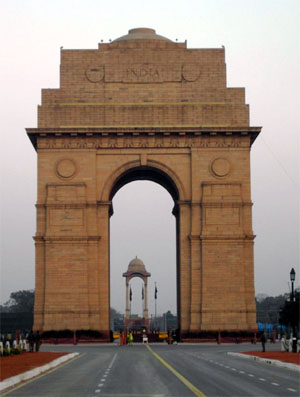Apr 14, 2025
Apr 14, 2025
by Azera Rahman
 Built by the British in memory of those who died fighting for the British Army in World War I, the India Gate monument in the heart of the national capital now holds an eternal flame to salute Indian soldiers who have sacrificed their lives for the country -- in every way a gate that is a bridge between the colonial past and the patriotic present.
Built by the British in memory of those who died fighting for the British Army in World War I, the India Gate monument in the heart of the national capital now holds an eternal flame to salute Indian soldiers who have sacrificed their lives for the country -- in every way a gate that is a bridge between the colonial past and the patriotic present.
The majestic 1931 monument, designed by Edwin Lutyens who planned what is the core of New Delhi, is the centerpiece of India's National Day celebrations every Jan 26 - the day when the country became a republic in 1950, about two and a half years after its independence on Aug 15, 1947.
The prime minister lays a wreath at the Amar Jawan Jyoti - literally the eternal soldier flame commemorating all the soldiers who sacrificed their lives for the country - before the grand Republic Day parade begins.
The times have changed but the sentiment is still perhaps the same as in 1921 when the foundation stone was laid by the Duke of Connaught and in 1931 when it was dedicated to the nation by the then viceroy Lord Irwin.
It was to salute the 90,000 Indian soldiers who were killed fighting for the British Army during World War I. The memorial, strikingly similar to the Arc de Triomphe archway in Paris, bears the names of more than 13,516 British and Indian soldiers killed in the Afghan war of 1919.
The Amar Jawan Jyoti was added much later. The eternal flame burns day and night under the arch to remind the nation of soldiers who laid down their lives in the India-Pakistan war of 1971.
But India Gate has come to mean more than a memorial to the dead soldier. It has also become a powerful platform for common people to voice their opinion. Candlelight vigils are often organised around the imposing monument to highlight various issues by civil society groups - be it the cause of justice for slain model Jessica Lal last year or HIV-AIDS victims this year.
Many peaceful protests have been organised by the public at India Gate to bring issues to the forefront and give it the necessary attention.
The entire arch of the India Gate stands on a low base of red Bharatpur stone and rises in stages to a huge moulding. The cornice is inscribed with the Imperial suns while both sides of the arch have 'India', flanked by the dates MCMXIV (1914 left) and MCMXIX (1919 right).
The shallow domed bowl at the top was intended to be filled with burning oil on anniversaries but this is rarely done.
The lawns around the place are a place for fun. The elderly stroll lazily, kids frolic on the lush lawns and couples snatch a private moment or two. Framed between the Rashtrapati Bhavan at one end and the India Gate at the other, the vast expanse of green space in the heart of Lutyen's Delhi is where people flock to when the weather is good. Or bad.
When the sun shines down warmly on a cold winter day, or when a soothing breeze wafts through on a hot summer, or just when it is stiflingly hot and some fresh air is all you need, the area around the colonial gate is where people come to.
On most evenings, the complex and its vast lawns resemble a mini carnival with large crowds, ice cream vendors doing brisk business and balloon sellers colouring the lawns.
Hopping off a screeching bus near India Gate, Manohar Joshi was one of the many who decided to spend an evening outdoors. Holding his wife's hand and carrying their son in his arms, he walked towards the stately memorial bustling with people.
"We generally come here on weekends. It is like a fair with hundreds of people talking, laughing and basically having a good time. Then there are vendors selling ice cream and other food items, balloons... it's like a picnic," said Joshi.
Families come by hordes to avoid the maddening rush at shopping malls and multiplexes.
Lots of people spread sheets on the lawns and sit there till late evening, chatting and munching on the goodies they brought in their picnic baskets or bought from hawkers.
Some also get photographs clicked by the professional photographers who roam around.
Several enthusiastic women get their hands and feet decorated with 'henna' by 'professionals' who look out for prospective customers with their henna tubes and a book full of designs.
As evening sets in, people hover around India Gate, soaking in its grandeur and the soft lighting.
"I come for a drive around India Gate every now and then. Although it's flocked by people, it is still such a breather from the overcrowded coffee shops or shopping malls," said Asmita Jain, who works in a public relations firm.
The India Gate stands tall in the heart of Delhi and is a must-see for the thousands of tourists, both domestic as well as international, who flock the capital every year.
19-Aug-2007
More by : Azera Rahman